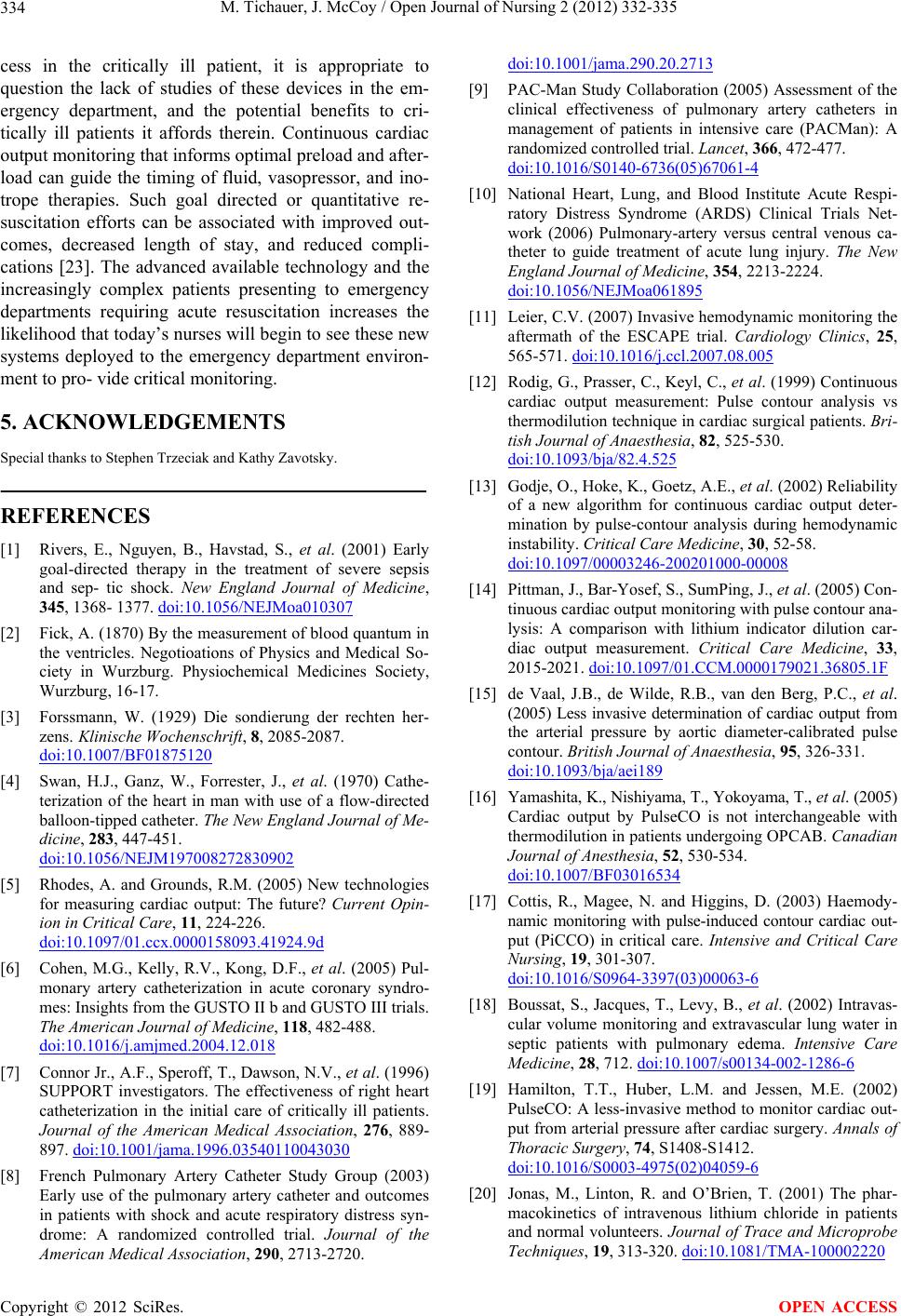
M. Tichauer, J. McCoy / Open Journal of Nursing 2 (2012) 332-335
334
cess in the critically ill patient, it is appropriate to
question the lack of studies of these devices in the em-
ergency department, and the potential benefits to cri-
tically ill patients it affords therein. Continuous cardiac
output monitoring that informs optimal preload and after-
load can guide the timing of fluid, vasopressor, and ino-
trope therapies. Such goal directed or quantitative re-
suscitation efforts can be associated with improved out-
comes, decreased length of stay, and reduced compli-
cations [23]. The advanced available technology and the
increasingly complex patients presenting to emergency
departments requiring acute resuscitation increases the
likelihood that tod ay’s nurses will begin to see these n ew
systems deployed to the emergency department environ-
ment to pro- vide critical monitoring.
5. ACKNOWLEDGEMENTS
Special thanks to Stephen Trzeciak and Kathy Zavotsky.
REFERENCES
[1] Rivers, E., Nguyen, B., Havstad, S., et al. (2001) Early
goal-directed therapy in the treatment of severe sepsis
and sep- tic shock. New England Journal of Medicine,
345, 1368- 1377. doi:10.1056/NEJMoa010307
[2] Fick, A. (1870) By the measurement of blood quantum in
the ventricles. Negotioations of Physics and Medical So-
ciety in Wurzburg. Physiochemical Medicines Society,
Wurzburg, 16-17.
[3] Forssmann, W. (1929) Die sondierung der rechten her-
zens. Klinische Wochenschrift, 8, 2085-2087.
doi:10.1007/BF01875120
[4] Swan, H.J., Ganz, W., Forrester, J., et al. (1970) Cathe-
terization of the heart in man with use of a flow-directed
balloon-tipped catheter. The New England Journal of Me-
dicine, 283, 447-451.
doi:10.1056/NEJM197008272830902
[5] Rhodes, A. and Grounds, R.M. (2005) New technologies
for measuring cardiac output: The future? Current Opin-
ion in Critical Care, 11, 224-226.
doi:10.1097/01.ccx.0000158093.41924.9d
[6] Cohen, M.G., Kelly, R.V., Kong, D.F., et al. (2005) Pul-
monary artery catheterization in acute coronary syndro-
mes: Insights from the GUSTO II b and GUSTO III trials.
The American Journal of Medicine, 118, 482-488.
doi:10.1016/j.amjmed.2004.12.018
[7] Connor Jr., A.F., Speroff, T., Dawson, N.V., et al. (1996)
SUPPORT investigators. The effectiveness of right heart
catheterization in the initial care of critically ill patients.
Journal of the American Medical Association, 276, 889-
897. doi:10.1001/jama.1996.03540110043030
[8] French Pulmonary Artery Catheter Study Group (2003)
Early use of the pulmonary artery catheter and outcomes
in patients with shock and acute respiratory distress syn-
drome: A randomized controlled trial. Journal of the
American Medical Association, 290, 2713-2720.
doi:10.1001/jama.290.20.2713
[9] PAC-Man Study Collaboration (2005) Assessment of the
clinical effectiveness of pulmonary artery catheters in
management of patients in intensive care (PACMan): A
randomized cont r olled trial. Lancet, 366, 472-477.
doi:10.1016/S0140-6736(05)67061-4
[10] National Heart, Lung, and Blood Institute Acute Respi-
ratory Distress Syndrome (ARDS) Clinical Trials Net-
work (2006) Pulmonary-artery versus central venous ca-
theter to guide treatment of acute lung injury. The New
England Journal of Medicine, 354, 2213-2224.
doi:10.1056/NEJMoa061895
[11] Leier, C.V. (2007) Invasive hemodynamic monitoring the
aftermath of the ESCAPE trial. Cardiology Clinics, 25,
565-571. doi:10.1016/j.ccl.2007.08.005
[12] Rodig, G., Prasser, C., Key l, C., et al. (1999) Continuous
cardiac output measurement: Pulse contour analysis vs
thermodilution technique in cardiac surgical patients. Bri-
tish Journal of Anaesthesia, 82, 525-530.
doi:10.1093/bja/82.4.525
[13] Godje, O., Hoke, K., Goetz, A.E., et al. (2002) Reliability
of a new algorithm for continuous cardiac output deter-
mination by pulse-contour analysis during hemodynamic
instability. Critical Care Medicine, 30, 52-58.
doi:10.1097/00003246-200201000-00008
[14] Pittman, J., Bar-Yosef, S., SumPing, J., et al. (2005) Con-
tinuous cardiac output monitoring with pulse contour ana-
lysis: A comparison with lithium indicator dilution car-
diac output measurement. Critical Care Medicine, 33,
2015-2021. doi:10.1097/01.CCM.0000179021.36805.1F
[15] de Vaal, J.B., de Wilde, R.B., van den Berg, P.C., et al.
(2005) Less invasive determination of cardiac output from
the arterial pressure by aortic diameter-calibrated pulse
contour. British Journal of Anaesthesia, 95, 326-331.
doi:10.1093/bja/aei189
[16] Yamashita, K., Nishiy ama, T., Yokoyama, T., et al. (2005)
Cardiac output by PulseCO is not interchangeable with
thermodilution in patients undergoing OPCAB. Canadian
Journal of Anesthesia, 52, 530-534.
doi:10.1007/BF03016534
[17] Cottis, R., Magee, N. and Higgins, D. (2003) Haemody-
namic monitoring with pulse-induced contour cardiac out-
put (PiCCO) in critical care. Intensive and Critical Care
Nursing, 19, 301-307.
doi:10.1016/S0964-3397(03)00063-6
[18] Boussat, S., Jacques, T., Levy, B., et al. (2002) Intravas-
cular volume monitoring and extravascular lung water in
septic patients with pulmonary edema. Intensive Care
Medicine, 28, 712. doi:10.1007/s00134-002-1286-6
[19] Hamilton, T.T., Huber, L.M. and Jessen, M.E. (2002)
PulseCO: A less-invasive method to monitor cardiac out-
put from arterial pressure after cardiac surgery. Annals of
Thoracic Surgery, 74, S1408-S1412.
doi:10.1016/S0003-4975(02)04059-6
[20] Jonas, M., Linton, R. and O’Brien, T. (2001) The phar-
macokinetics of intravenous lithium chloride in patients
and normal volunteers. Journal of Trace and Microprobe
Techniques, 19, 313-320. doi:10.1081/TMA-100002220
Copyright © 2012 SciRes. OPEN ACCESS